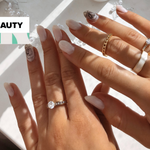If you listen to the latest beauty buzz, it’s easy to discern which ingredients are good for your skin. Niacinamide, hyaluronic acid, and ceramides are just a few that immediately come to mind. From boosting hydration to supporting your skin’s barrier and improving resiliency, there are plenty of skincare products with great ingredients to be found.
And, of course, there’s a flip side; for every good ingredient to be found in skincare products, there are many more that aren’t so good for you or your skin. Let’s take a closer look at a few of the most popular skincare ingredients to avoid.
Parabens
In layman’s terms, parabens are preservatives, and they’re found in myriad skincare products including soaps, lotions, and makeup. While they serve a desirable purpose – staving off bacteria, the potential side effects are hair-raising. The fact is, parabens are known endocrine disruptors. Not only can they lead to hormonal imbalances, but parabens have been linked to breast cancer as well. One eye-opening study, found in the Journal of Applied Toxicology, showed that 99% of all breast cancer tumors contained parabens.
What to look for: When you’re shopping for a new shampoo or conditioner, look for labels that say “paraben-free.” If that information is not readily available, then be sure to look for any of the three most common parabens on the ingredient list:
- butylparaben
- methylparaben
- propylparaben
Sodium Lauryl Sulfate
Sodium Lauryl Sulfate is a commonly used foaming agent in soaps and shampoos. While these surfactants have nothing to do with how clean your “clean” is, most just people like to see the suds “sudsing” to feel like they’re working.
Unfortunately, sodium lauryl sulfate can cause skin irritation and allergic reactions. Moreover, these sulfates can irritate the eyes, skin, and lungs, and they are also known to cause cancer in laboratory mice.
What to look for: When shopping for personal care products and household cleaners, look out for sodium lauryl sulfate and sodium laureth sulfate.
Toluene
Typically found in nail polish and hair dyes, toluene is a toxic solvent. Exposure to toluene can cause eye, nose, and skin irritation, but it’s also associated with nerve, liver, and kidney damage. Moreover, toluene is toxic to the immune system, and pregnant women are strongly cautioned to steer clear as toluene has been linked to birth defects.
What to look for: The good news here is that toluene does not hide behind other names that disguise its identity. If you’re looking to steer clear of this toxic chemical, simply just be sure that toluene is not listed as an ingredient.
Phthalates
Phthalates are plasticizers commonly used to improve the durability and flexibility of plastic containers. Surprisingly, phthalates are found in thousands of product categories including, toys, vinyl flooring, detergents, food packaging, pharmaceuticals, and of course, myriad personal care products. In cosmetics and skincare products, phthalates act as a solvent or a binding agent. And much like parabens, phthalates are endocrine disruptors that are known to cause hormonal and reproductive issues.
What to look for: When you’re shopping for any of the product categories listed above, be sure to check the label for phthalate, DEP, DBP, DEHP, and fragrance.
Oxybenzone
Commonly found in sunscreens, oxybenzone is likely the most worrisome chemical sunscreen around. This sunscreen is a known endocrine disruptor, and it has been shown to alter thyroid function. Chemical sunscreens work by being absorbed into the skin, and therein lies the problem. A 2020 study by the FDA showed that these sunscreens that have been linked to male infertility, hormone disruption, and cancer are detectable in the bloodstream weeks after application. Oxybenzone, in particular, showed concentrations in the bloodstream that was 180 times the FDA’s comfort level after a single application. None of this is good.
What to look for: While mineral sunscreens are growing in popularity, chemical sunscreens are still widely available. To steer clear of these bad boys, look for ingredients like avobenzone, oxybenzone, octocrylene, and ecamsule.
And there you have it, five of the worst offenders when it comes to dangerous ingredients in your personal care products. The good news is that awareness of the dangers associated with these products is increasing, and watchdog groups like the FDA are responding in kind. No doubt that with a little more research, these products may eventually be off the market for good.







